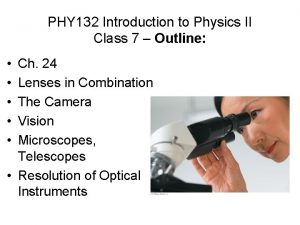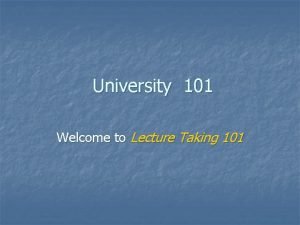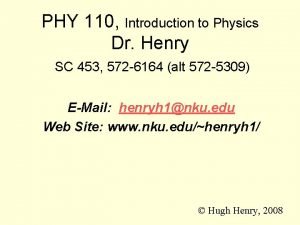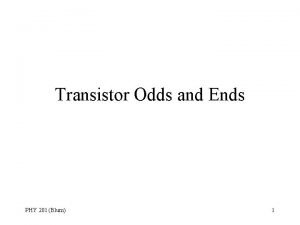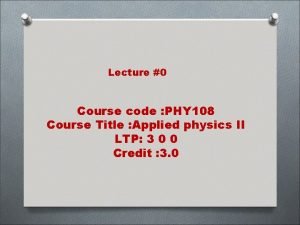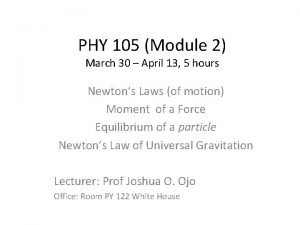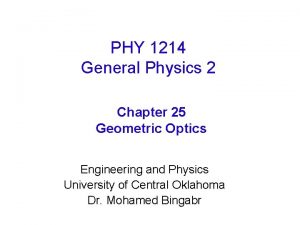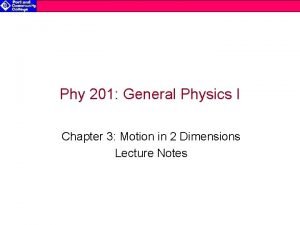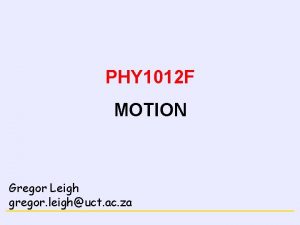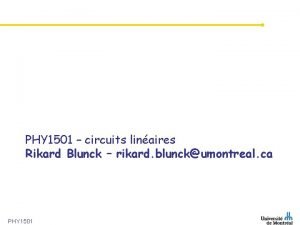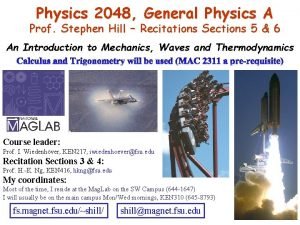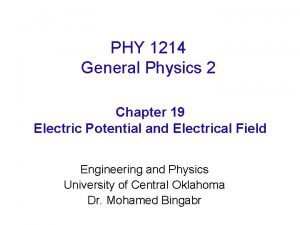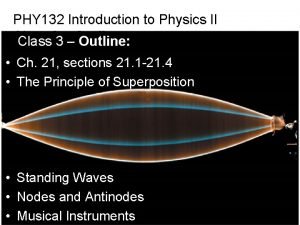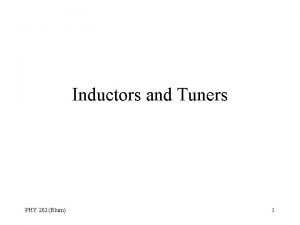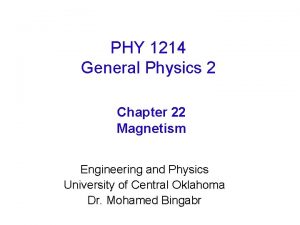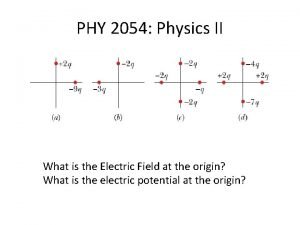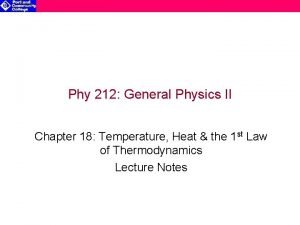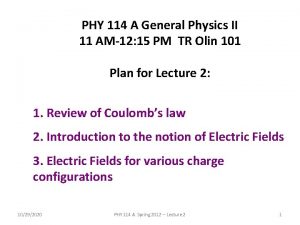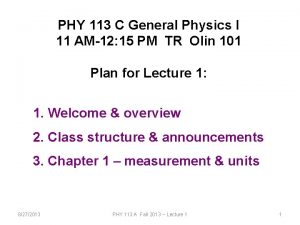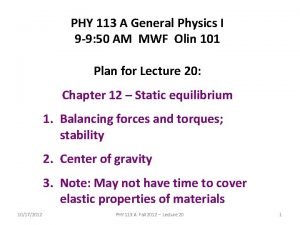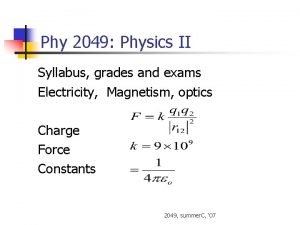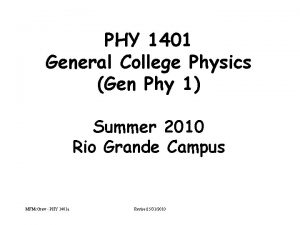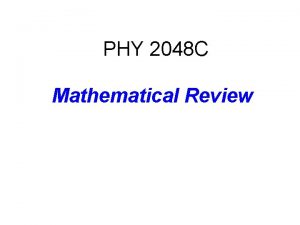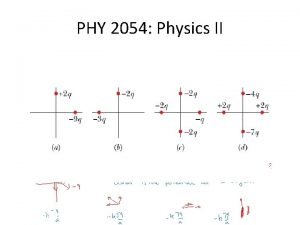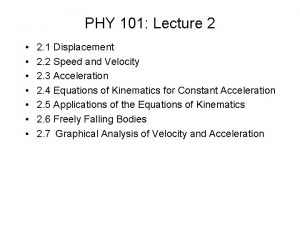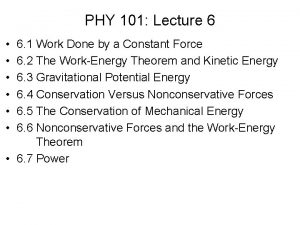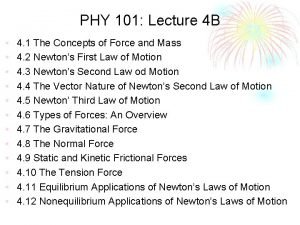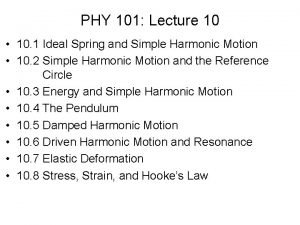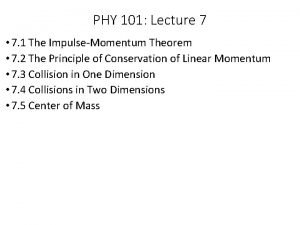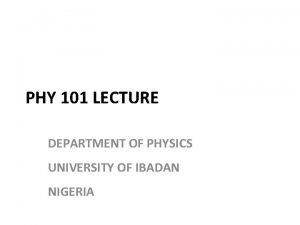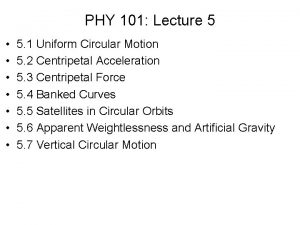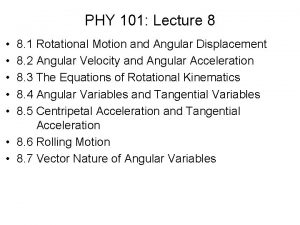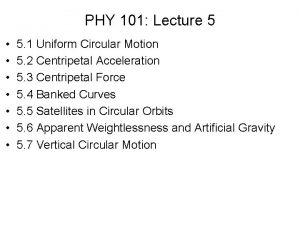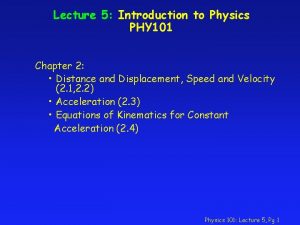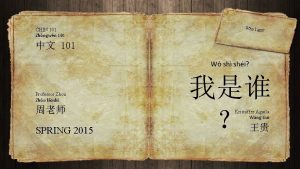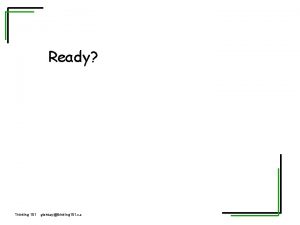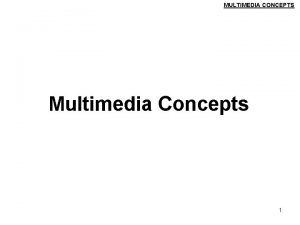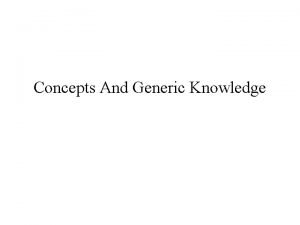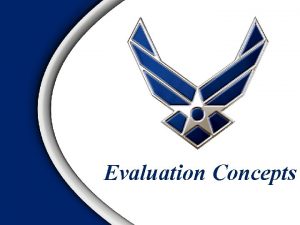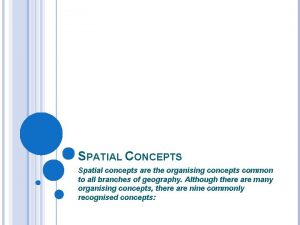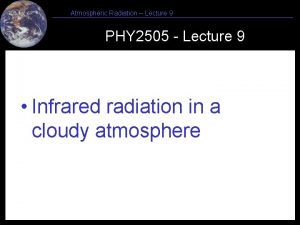PHY 101 Lecture 4 4 1 The Concepts













































- Slides: 45

PHY 101: Lecture 4 • • • 4. 1 The Concepts of Force and Mass 4. 2 Newton’s First Law of Motion 4. 3 Newton’s Second Law od Motion 4. 4 The Vector Nature of Newton’s Second Law of Motion 4. 5 Newton’ Third Law of Motion 4. 6 Types of Forces: An Overview 4. 7 The Gravitational Force 4. 8 The Normal Force 4. 9 Static and Kinetic Frictional Forces 4. 10 The Tension Force 4. 11 Equilibrium Applications of Newton’s Laws of Motion 4. 12 Nonequilibrium Applications of Newton’s Laws of Motion

Dynamics History - 1 • Aristotle (384 BC to 322 BC) • Observed nature, philosophized about nature, did no experiments • Natural Motion (sub-lunar) – Elements earth, air, water, and fire seek their natural place – Earth / water move straight down, air / fire move straight up • Natural Motion (supralunar) – Heavenly bodies are made from a fifth element, quintessence – The natural state is circular motion • Violent Motion – Objects are moved by force • The normal state of motion on earth is rest • Heavy objects have a greater desire to reach their natural place than light objects and therefore fall faster • Speed of fall depends inversely on density of medium it falls through • No vacuum, because object would move through it with infinite speed • These statements accepted in Europe for nearly 2, 000 years

Dynamics History - 2 • Beginning with Medieval Europe and continuing into the Renaissance, some Europeans and Muslims made contributions to dynamics • Abu Sahl al-Quhi (Kuhi) (1000) – Discovers that the heaviness of bodies vary with their distance from the center of the Earth • Ibn al-Haytham (1000 – 1037) – Discusses theory of attraction between masses – Seems that he was aware of the magnitude of acceleration due to gravity – Discovered the law of inertia, known as Newton's first law of motion, when he stated that a body moves perpetually unless an external force stops it or changes its direction of motion • Avicenna (1000 -1037) – Father of the fundamental concept of momentum in physics – Discovered the concept of momentum, when he referred to impetus as being proportional to weight times velocity, a precursor to the concept of momentum in Newton's second law of motion – His theory of motion was also consistent with the concept of inertia in Newton's first law of motion

Dynamics History – 3 • Abu Rayhan al-Biruni (1000 – 1048) – Was the first to realize that acceleration is connected with non-uniform motion • Ibn Bajjah (Avempace) (1100 – 1138) – First to state that there is always a reaction force for every force exerted – Precursor to Gottfried Leibniz's idea of force which underlies Newton's third law of motion – His theory of motion later has an important influence on later physicists like Galileo Galilei • Hibat Allah Abu'l-Barakat al-Baghdaadi (1100 – 1165) – Writes a critique of Aristotelian philosophy and Aristotelian physics – First to negate Aristotle's idea that a constant force produces uniform motion, as he realizes that a force applied continuously produces acceleration, which is considered "the fundamental law of classical mechanics" and an early foreshadowing of Newton's second law of motion – Like Newton, he described acceleration as the rate of change of velocity

Dynamics History – 4 • Al-Khazini (1121) – Publishes The Book of the Balance of Wisdom, in which he is the first to propose that the gravity and gravitational potential energy of a body varies depending on its distance from the center of the Earth – This phenomenon is not proven until Newton's law of universal gravitation – One of the first to clearly differentiate between force, mass, and weight – He and his Muslim predecessors unified statics and dynamics into the science of mechanics – The contributions of al-Khazini and his Muslim predecessors to mechanics laid the foundations for the later development of classical mechanics in Renaissance Europe

Dynamics History – 5 • Jean Boridan (1355) – The concept of inertia was alien to the physics of Aristotle – Aristotle held that a body was only maintained in motion by the action of a continuous external force – In the Aristotelian view, a projectile moving through the air owed its continuing motion to eddies or vibrations in the surrounding medium – Jean Buridan proposed that motion was maintained by some property of the body, imparted when it was set in motion – Buridan named the motion-maintaining property impetus – He rejected the view that the impetus dissipated spontaneously asserting that a body would be arrested by the forces of air resistance and gravity which might be opposing its impetus – Buridan further held that the impetus of a body increased with the speed with which it was set in motion, and with its quantity of matter – Buridan's impetus is related to the modern concept of momentum – Buridan saw impetus as causing the motion of the object – Buridan anticipated Isaac Newton when he wrote: • . . . after leaving the arm of the thrower, the projectile would be moved by an impetus given to it by the thrower and would continue to be moved as long as the impetus remained stronger than the resistance, and would be of infinite duration were it not diminished and corrupted by a contrary force resisting it or by something inclining it to a contrary motion

Dynamics History – 6 • Niccolo Tartaglia (1537) – First to apply mathematics to the investigation of the paths of cannonballs – His work was later validated by Galileo’s studies on falling bodies • Giambattista Benedetti (1553) – Benedetti proposed a new doctrine of the speed of bodies in free fall – The accepted Aristotelian doctrine at that time was that the speed of a freely falling body is directly proportional to the total weight of the body and inversely proportional to the density of the medium – As opposed to the Aristotelian theory, his theory predicts that two objects of the same material but of different weights would fall at the same speed, and also that objects of different materials in a vacuum would fall at different though finite speeds – In a second edition of the Demonstratio (1554), he extended this theory to include the effect of the resistance of the medium, which he said was proportional to the cross section or the surface area of the body – Two objects of the same material but of different surface areas would only fall at equal speeds in a vacuum – It is thought that Galileo derived his initial theory of the speed of a freely falling body from his reading of Benedetti's works – The account found in Galileo's De motu, his early work on the science of motion, follows Benedetti's initial theory as described above – In this early work, Galileo also subscribes to theory of impetus

Dynamics History - 7 • Giovanni Benedetti (1553, 1585) – He stated that bodies composed of the same material fell at the same speed regardless of their weight – At this time Aristotle’s views were accepted without question – What Benedetti was putting forward was in complete contradiction to Aristotle – Those who read Benedetti's work did not accept his ideas – Some argued that his idea was stupid – Other agreed with his findings but said that they must be in agreement with Aristotle – Benedetti himself remarks that he had critics in Rome who said that Aristotle was always right, so his work must be wrong • Simon Stevin (1586) – Demonstrated that two objects of different weight fall down with exactly the same acceleration

Dynamics History - 8 • • Galileo Galilei (1564 – 1642) Used reasoning, thought experiments and actual experiments Mostly developed kinematics Developed concept of acceleration Falling objects accelerate uniformly, and fall with the same speed Air retards falling objects such as a feather Distance traveled by objects under uniform acceleration increases by t 2 • Motion of a projectile falling freely under gravity is compound consisting of uniform motion horizontally and uniform accelerating motion vertically • Law of Inertia: – Objects want to move in a straight line with constant velocity – Objects don’t stop moving when the force is removed – Friction force stops motion – Unbalanced forces keep objects from moving in a straight line with constant velocity

Dynamics History - 9 • Isaac Newton (1643 – 1727) – Law of Gravity – Laws of Motion – Established modern study of optics – First reflecting telescope – Invented Calculus – Alchemy

PHY 101: Lecture 4 Force and Newton’s Laws of Motion 4. 1 The Concepts of Force and Mass

Concept of Force - 1 • A force is a push or a pull • Force is a vector • Contact Force: – Arise from the physical contact between two objects • Noncontact Forces or Action-at-a-distance Forces: – Two objects exert forces on one another even though they are not touching – For example, gravity

Concept of Mass - 1 • The mass of an object determines how easily a force can move the object • Mass is a scalar

PHY 101: Lecture 4 Force and Newton’s Laws of Motion 4. 2 Newton’s First Law of Motion

Newton’s First Law • An object continues in a state of rest or in a state of motion at a constant speed along a straight line, unless compelled to change that state by a net force – Net force is vector sum of all forces acting simultaneously on a body • Inertia is the natural tendency of an object to remain at rest or in motion at a constant speed along a straight line – Greater inertia of an object greater the net force required to change its velocity • Mass of an object is a quantitative measure of inertia

Purpose of Newton’s First Law • First law is redundant with second law • What is purpose of the first law? ØDefine force • Push or pull that could potentially cause motion ØDefine when First Law works

Newton’s First Law - 1 • In the absence of external forces • It is possible to identify a reference frame in which the object has zero acceleration • This defines where the first law works – It defines a special set of reference frames called inertial frames • We call this an inertial frame of reference

Newton’s First Law – 2 • In the absence of external forces • When viewed from an inertial reference frame • An object at rest remains at rest and • An object in motion continues in motion with a constant velocity

Inertial Frames • Any reference frame that moves with constant velocity relative to an inertial frame is itself an inertial frame • If you accelerate relative to an object in an inertial frame, you are observing the object from a non-inertial reference frame • A reference frame that moves with constant velocity relative to the distant stars is the best approximation of an inertial frame – We can consider the Earth to be such an inertial frame, although it has a small centripetal acceleration associated with its motion

Frames of Reference -1 • Frame of reference is x, y, z coordinate system • Example – – Person A is standing on a train platform A ball sits on the platform next to the Person A A train with velocity of 120 km/hr passes platform The x, y, z coordinate system fixed in the Person A is the platform frame of reference – The x, y, z coordinate system fixed in Person B sitting on the train is the train frame of reference – Train frame of reference moves with a velocity of 120 km/hr relative to the platform frame of reference

Frames of Reference - 2 Train B v = 120 km/hr A Platform

Inertial Frame of Reference - 1 • An inertial frame of reference is a frame of reference in which Newton’s First Law is obeyed – Newton’s First Law is not obeyed if an object is seen accelerating and there is no obvious force

Inertial Frame of Reference - 2 • Person A (platform) sees ball next to him • He sees no horizontal force on the ball and no horizontal acceleration of the ball • Person A says Newton’s First Law obeyed • Person B (train) sees that the ball is travelling backwards at a constant velocity of 120 km/hr • He also sees no horizontal force on the ball and no horizontal acceleration of the ball • Person B says Newton’s First Law is obeyed

Inertial Reference Frame - 3 • A frame of reference in which Newton’s First Law is obeyed is an inertial frame of reference Every other frame moving at a constant velocity relative to the first frame is also an inertial frame of reference

Non-Inertial Frame of Reference - 1 Truck observer Ground observer • • Flat bed truck that is not moving A box sits on the bed at the front of the truck There is no friction between the truck and box There are two observers – 1. Fixed on the truck – 2. Fixed on the ground

Non-Inertial Frame of Reference - 2 Truck observer Ground observer • Truck begins to accelerate to the left

Non-Inertial Frame of Reference - 3 • Ground observer sees – Truck accelerates to the left – There is no force on the box – The box does not move – Newton’s first law is obeyed • Ground observer is an inertial frame of reference

Non-Inertial Frame of Reference - 4 • Truck observer sees – Truck does not move – There is no force on the box – Box accelerates towards him(her) – Newton’s first law is not obeyed • Train observer is a non-inertial frame of reference • Train observer believes a new fictitious force is moving the box towards him(her)

Non-Inertial Frame of Reference - 3 • Train observer sees – Truck accelerates to the left – There is no force on the box – The box does not move – Newton’s first law is obeyed • Ground observer is an inertial frame of reference

PHY 101: Lecture 4 Force and Newton’s Laws of Motion 4. 3 Newton’s Second Law of Motion

Newton’s Second Law • Newton’s Statement of the Law – A measure of motion is momentum = p = mv – The greater the “motion” the greater is mv – Rate of change of momentum = SF – SF = Dp/Dt = D(mv)/Dt = [(mv)f – (mv)i]/Dt – Force, momentum and velocity are vectors – SF means sum of external forces

Newton’s Second Law Force - Acceleration • Contemporary Statement of the Law – Mass does not change, then – SF = Dp/Dt = D(mv)/Dt = m. Dv/Dt = ma – SF = ma

Newton’s Second Law Definitions • External Forces – Net force includes only the forces that the environment exerts on the object • Internal Forces – Forces that one part of an object exerts on another part of the object – These are not included in the second law

Unit of Force • • SI unit of force is the Newton (N) This a derived unit = kg(m/s 2) Weight is the force of gravity If you held a weight of 3. 5 ounces in the palm of your hand you would feel the force of 1 Newton • This is very little force

Newton’s Second Law Example 1 • A 3. 0 -N net force is applied to 1. 5 -kg mass • What is the object’s acceleration? – Magnitude • F = ma • a = F/m = 3. 0 N / 1. 5 kg = 2. 0 m/s 2 – Direction • In the direction of the net force

Newton’s Second Law Example 2 • Engine of a 1. 0 -kg toy plane exerts a 15 -N forward force • Air exerts a 8. 0 -N resistive force on the plane • The resistive force of the air is negative (-) • What is the magnitude of the acceleration of the plane? Ø F = ma Ø 15 – 8. 0 = 1. 0 a Ø 7. 0 = 1. 0 a Ø a = 7. 0/1. 0 = 7. 0 m/s 2

Newton’s Second Law Example 3 • A boy pulls a box of mass 30 kg with a force of 25 N that makes an angle of 300 with the horizontal direction • What is the acceleration of the box? ØWe are only interested in x-component (horizontal) of force and acceleration ØF = ma Ø 25 cos(30) = 30 a Øa = 25 cos(30)/30 = 0. 72 m/s 2

PHY 101: Lecture 4 Force and Newton’s Laws of Motion 4. 4 The Vector Nature of Newton’s Second Law of Motion

Newton’s Second Law Vector Nature § SFx = max § SFy = may • F, p, and a are positive or negative, depending on whether they point along the positive or negative x or y axis

Newton’s Second Law Example 4 • • • Two boats pull a 75. 0 -kg water skier Each boat pulls with a force of 600 N One boat pulls 450 above the horizontal axis The other boat pull 450 below the horizontal axis The skier travels at a constant velocity What is the magnitude of the retarding force between the water and the skis? Ø Let direction of motion be in the +x direction Ø Work with vector x-components Ø Ncos(45) + Ncos(45) - Fretarding = ma = 0 Ø 2(600)cos(45) = Fretarding = 849 N

PHY 101: Lecture 4 Force and Newton’s Laws of Motion 4. 5 Newton’s Third Law of Motion

Newton’s Third Law - 1 • Newton’s Statement of the Law – A system consists of objects 1 and 2 – Objects 1 and 2 exert internal forces on each other – There is no external force – F 12 is the internal force of object 1 on object 2 – Apply Newton’s Second Law to the system v. D(p 1 + p 2)/Dt = 0

Newton’s Third Law - 2 • Newton’s Statement of the Law v. D(p 1 + p 2)/Dt = 0 v. Dp 1/Dt = -Dp 2/Dt = 0 v. Apply Newton’s Second Law separately to objects 1 and 2 v. F 21 = - F 12 v. Forces are equal in magnitude v. Forces are opposite in direction v. Sum of momentums of two objects is conserved (unchanged)

Newton’s Third Law - 3 • Contemporary Statement of the Law v. When one body exerts a force on a second body, the second body exerts an oppositely directed force of equal magnitude on the first body

Third Law - Example • In an Olympic figure-skating event, a 60 -kg male skater pushes a 45 -kg female skater, causing her to accelerate at a rate of 2. 0 m/s 2 • At what rate will the male skater accelerate? v Female Skater v F = ma = 45 x 2 = 90 N v Male Skater v Male skater pushes on the female skater with a force of 90 N v Using Newton’s third law, the female skater pushes back on the male skater with a force of 90 N v F = ma v a = F/m = 90/60 = 1. 5 m/s 2
 Nearsightedness physics
Nearsightedness physics 01:640:244 lecture notes - lecture 15: plat, idah, farad
01:640:244 lecture notes - lecture 15: plat, idah, farad Physics 101 lecture notes pdf
Physics 101 lecture notes pdf Physics 101 lecture
Physics 101 lecture Waves 2 physics notes
Waves 2 physics notes Lecture 101
Lecture 101 Phy101 lecture 1
Phy101 lecture 1 Phy 110
Phy 110 Pa msu
Pa msu Life phy
Life phy Phy
Phy Phy108
Phy108 Phy-105 5 discussion
Phy-105 5 discussion Phy113
Phy113 Phy 1214
Phy 1214 Phy 2049
Phy 2049 Vx=vox+axt
Vx=vox+axt Complete motion diagram
Complete motion diagram Phy theorem
Phy theorem Phy circuit
Phy circuit Atm packet phy
Atm packet phy Phy tgen
Phy tgen Phy 131 asu
Phy 131 asu Phy 2048c fsu
Phy 2048c fsu Phy 1214
Phy 1214 Phy
Phy Phy 132
Phy 132 Felix connects a wire coil to an ammeter
Felix connects a wire coil to an ammeter Phy 221 msu
Phy 221 msu General physics
General physics Fizik ii
Fizik ii Phy 205
Phy 205 Ddr phy architecture
Ddr phy architecture Phy 212
Phy 212 Phy 131 past papers
Phy 131 past papers Phy
Phy Phy
Phy Phy 1214
Phy 1214 Phy theorem
Phy theorem 2012 phy
2012 phy Phy 2049
Phy 2049 Eye phy
Eye phy General physics measurement
General physics measurement Tia chieu sa te
Tia chieu sa te Các châu lục và đại dương trên thế giới
Các châu lục và đại dương trên thế giới Một số thể thơ truyền thống
Một số thể thơ truyền thống
